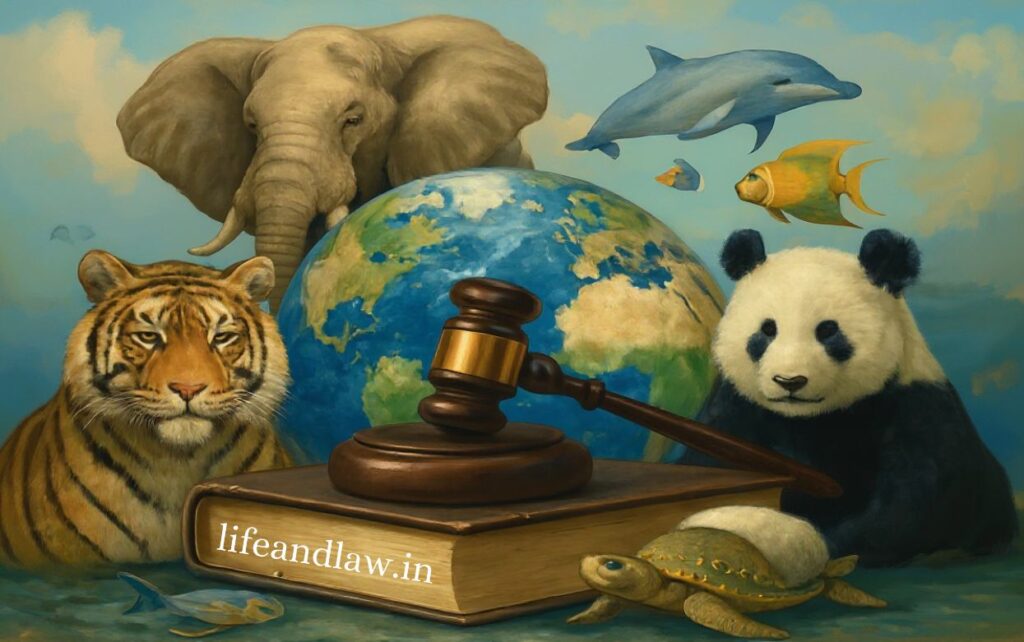Trending

Wildlife is critical to sustaining Earth’s ecological equilibrium. The survival of numerous species ensures that ecosystems work properly, which has a direct impact on agriculture, the climate, and human life. However, rising human activities such as deforestation, urbanisation, pollution, and climate change are driving many animal and plant species to extinction. This poses major hazards to both the environment and humanity. Biodiversity protection is thus a shared obligation that extends beyond scientists and environmentalists to society as a whole.
‘World Wildlife Day’ is celebrated to raise awareness and encourage public participation in wildlife conservation. This article discusses the significance of wildlife conservation, applicable laws, current issues, and practical solutions.
Wildlife is critical to preserving biodiversity and ecological equilibrium. The interdependence of flora and wildlife keeps natural cycles going that support agriculture, regulate the climate, and sustain human life. Thus, wildlife conservation is critical for both the ecosystem and human well-being.
However, increased human meddling has resulted in habitat loss. Deforestation, poaching, pollution, and climate changes are all threatening many species. These dangers underline the need for tight legal frameworks and increased public awareness to safeguard animals.
Wildlife Protection Act, 1972: This act is crucial for protecting wild species and their habitats in India. It gives legal protection to many endangered species and makes hunting illegal. It also encourages the creation of national parks and wildlife refuges. The act establishes provisions for punishing wildlife offences such as poaching and trafficking.
Environmental Protection Act, 1986: This act, introduced to address environmental degradation, empowers the government to control initiatives that have an impact on ecosystems. It helps to preserve habitats by lowering pollution and regulating deforestation, so indirectly safeguarding bio-diversity and wildlife.
Biological Diversity Act, 2002: This legislation seeks to protect India’s unique biodiversity by prioritising the sustainable use of biological resources and the preservation of traditional knowledge. It also forbids illegal exploitation by foreign organisations and grants local communities authority over their biological resources.
Indian Forest Act, 1927: As India’s oldest forestry law, it protects and conserves natural resources. It provides protected forest areas, prevents illegal exploitation, and authorises local governments to carry out conservation measures. This indirectly encourages biodiversity and wildlife conservation.
Impact of Deforestation and Urbanization: Expanding urban infrastructure, agriculture, and industry have resulted in widespread deforestation, eliminating the habitats of many wild animals. This forces animals such as tigers, elephants, and leopards into human settlements, escalating conflict and decreasing their chances of survival.
Poaching and Wildlife Trafficking:
The illegal hunting and trade of animals have become international crimes. Tiger skins, elephant tusks, and rhino horns are highly valued for traditional medicine, ornamentation, and other purposes. Such activities jeopardise the survival of numerous species.
Climate Change and Its Impact on Biodiversity: Climate change is affecting ecosystems all across the world. Rising temperatures, irregular rainfall, and forest fires are devastating ecosystems. Melting glaciers in the Himalayas are having an impact on cold-climate wildlife such as snow leopards.
Human-Wildlife Conflict: As woods diminish, wild animals enter communities in quest of food and water, resulting in confrontations with humans. Tigers and elephants are destroying cattle and damaging crops in areas such as Maharashtra, causing conflict between conservation efforts and local populations.
Governments must implement existing legislation, such as the Wildlife Protection Act of 1972, and improve administration of national parks and sanctuaries. Forest departments must stay diligent in combating poaching and trafficking.
Individual choices matter. Avoiding trash, avoiding littering in forests, utilising sustainable products, not buying wildlife-derived goods, and following local norms during eco-tourism can all help with conservation.
Public participation in conservation efforts is critical. Participating in tree-planting programs, supporting non-governmental organisations (NGOs), reporting unlawful actions, and preserving biodiversity all assist to boost conservation efforts.
Raising awareness in schools, universities, and communities can result in long-term change. Documentaries, social media, and eco-tourism are all useful tools for educating the general public. Training farmers and tribal populations in sustainable methods promotes grassroots conservation.
World Wildlife Day serves as a poignant reminder of our shared responsibility to protect the planet’s biodiversity. Every step, from implementing animal protection laws to combating illegal poaching and supporting sustainable practices, is critical to protecting fragile habitats.
Adv. Abdul Mulla‘s through legal platforms www.asmlegalservices and www.lifeandlaw.in frequently emphasise the need of legal frameworks in conservation initiatives. His work emphasises that wildlife protection is more than just a government responsibility; citizens must also participate in awareness campaigns, sustainable living, and community-based conservation.
Adv. Abdul Mulla (Mob. No. 937 007 2022) is a seasoned legal professional with over 18 years of experience in advocacy, specializing in diverse areas of law, including Real Estate and Property Law, Matrimonial and Divorce Matters, Litigation and Dispute Resolution, and Will and Succession Planning. read more….
Copyright BlazeThemes. 2025